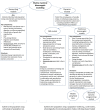A review of bioenergetic modelling for marine mammal populations
- PMID: 35754757
- PMCID: PMC9215292
- DOI: 10.1093/conphys/coac036
A review of bioenergetic modelling for marine mammal populations
Abstract
Bioenergetic models describe the processes through which animals acquire energy from resources in the environment and allocate it to different life history functions. They capture some of the fundamental mechanisms regulating individuals, populations and ecosystems and have thus been used in a wide variety of theoretical and applied contexts. Here, I review the development of bioenergetic models for marine mammals and their application to management and conservation. For these long-lived, wide-ranging species, bioenergetic approaches were initially used to assess the energy requirements and prey consumption of individuals and populations. Increasingly, models are developed to describe the dynamics of energy intake and allocation and predict how resulting body reserves, vital rates and population dynamics might change as external conditions vary. The building blocks required to develop such models include estimates of intake rate, maintenance costs, growth patterns, energy storage and the dynamics of gestation and lactation, as well as rules for prioritizing allocation. I describe how these components have been parameterized for marine mammals and highlight critical research gaps. Large variation exists among available analytical approaches, reflecting the large range of life histories, management needs and data availability across studies. Flexibility in modelling strategy has supported tailored applications to specific case studies but has resulted in limited generality. Despite the many empirical and theoretical uncertainties that remain, bioenergetic models can be used to predict individual and population responses to environmental change and other anthropogenic impacts, thus providing powerful tools to inform effective management and conservation.
Keywords: bioenergetic models; cetaceans; energy budgets; individual-based modelling; pinnipeds; population consequences of disturbance.
© The Author(s) 2022. Published by Oxford University Press and the Society for Experimental Biology.
Figures


References
-
- Acevedo J, Urbán J (2021) Estimates of Fuegian sprat consumption by humpback whales in the Magellan Strait feeding area as predicted by a bioenergetic model. Mar Ecol Prog Ser 657: 223–239.
-
- Banas NS, Møller EF, Laidre KL, Simon M, Ellingsen IH, Nielsen TG (2021) Reconciling behavioural, bioenergetic, and oceanographic views of bowhead whale predation on overwintering copepods at an Arctic hotspot (Disko Bay, Greenland). Front Mar Sci 8: 1–9. - PubMed
-
- Bejarano AC, Wells RS, Costa DP (2017) Development of a bioenergetic model for estimating energy requirements and prey biomass consumption of the bottlenose dolphin Tursiops truncatus. Ecol Model 356: 162–172.
-
- Beltran RS, Testa JW, Burns JM (2017) An agent-based bioenergetics model for predicting impacts of environmental change on a top marine predator, the Weddell seal. Ecol Model 351: 36–50.
-
- Bennett KA, Speakman JR, Moss SEW, Pomeroy P, Fedak MA (2007) Effects of mass and body composition on fasting fuel utilisation in grey seal pups (Halichoerus grypus Fabricius): an experimental study using supplementary feeding. J Exp Biol 210: 3043–3053. - PubMed
LinkOut - more resources
Full Text Sources

